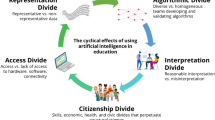Abstract
Educators in health professions education should know about current issues and emerging trends related to their roles and the field at large. This knowledge informs scholarly work and helps identify best practices to adopt, pitfalls to avoid, and role models to emulate. The literature and expert opinion suggest a four-stage approach for educators to maintain their knowledge of best practices: PLAN, PULL, PUSH, and PLAY. This paper proposes strategies to show how a deliberate approach, supported with technology, may make the overwhelming task of staying up-to-date in the ever-changing field of medical education more manageable and personally rewarding.

Similar content being viewed by others
References
Srinivasan M, Li ST, Meyers FJ, Pratt DD, Collins JB, Braddock C, et al. “Teaching as a competency”: competencies for medical educators. Acad Med. 2011;86(10):1211–20.
Glassick CE. Boyer’s expanded definitions of scholarship, the standards for assessing scholarship, and the elusiveness of the scholarship of teaching. Acad Med. 2000;75(9):877–80.
Beckman TJ, Cook DA. Developing scholarly projects in education: a primer for medical teachers. Med Teach. 2007;29:210–8.
Crites GE, Gaines JK, Cottrell S, Kalishman S, Gusic M, Mavis B, et al. Medical education scholarship: an introductory guide: AMEE guide No. 89. Med Teach. 2014;36(8):657–74.
Simpson D, Fincher RE, Hafler JP, Irby DM, Richards BF, Rosenfeld GC, et al. Advancing educators and education by defining the components and evidence associated with educational scholarship. Med Ed. 2007;41:1002–9.
McGaghie WC. Scholarship, publication, and career advancement in health professions education: AMEE Guide No. 43. Med Teach. 2009;31:574–90.
Laine C, Weinberg DS. How can physicians keep up-to-date? Annu Rev Med. 1999;50:99–110.
Haynes RB, McKibbon KA, Fitzgerald D, Guyatt GH, Walker CJ, Sackett DL. How to keep up with the medical literature: I. Why to try to keep up and how to get started. Ann Intern Med. 1986;105(1):149–53.
Haig A, Dozier M. BEME guide no. 3: systematic searching for evidence in medical education – part 1: sources of information. Med Teach. 2003;25(4):352–63.
Haig A, Dozier M. BEME guide no. 3: systematic searching for evidence in medical education – part 2: constructing searches. Med Teach. 2003;25(5):463–84.
Maggio LA, Tannery NH, Kanter SL. AM last page: how to perform an effective database search. Acad Med. 2011;86(8):1057.
AAMC-GEA-MESRE Section. Annotated bibliography of journals for educational scholarship Washington, DC: Association of American Medical Colleges. 2014. https://www.aamc.org/download/184694/data/annotated_bibliography_of_journals.pdf. Accessed 8 Sep 2014.
Poirier T, Behnen E. Where and how to search for evidence in the education literature. The WHEEL. 2014. doi:10.56888/ajpe78470.
Haynes RB, McKibbon KA, Fitzgerald D, Guyatt GH, Walker CJ, Sackett DL. How to keep up with the medical literature: II. Deciding which journals to read regularly. Ann Intern Med. 1986;105(2):309–12.
Haynes RB, McKibbon KA, Fitzgerald D, Guyatt GH, Walker CJ, Sackett DL. How to keep up with the medical literature: III. Expanding the number of journals you read regularly. Ann Intern Med. 1986;105(3):474–8.
Prochaska JO, Velicer WF. The transtheoretical model of health behavior change. Am J Health Promot. 1997;12(1):38–48.
Citrome L, Moss SV, Graf C. How to search and harvest the medical literature: let the citations come to you, and how to proceed when the do. Int J Clin Pract. 2009;63(11):1565–70.
Slusarski SB. Enhancing professional development through reading professional literature. Anaheim: Paper presented at the annual meeting of the American Association of Adult and Continuing Education; 1992.
Shaughnessy AF. Keeping up with the medical literature: how to set up a system. Am Fam Physician. 2009;79(1):25–6.
Wenger E. Communities of practice: learning, meaning, and identity. Cambridge: Cambridge University Press; 1998.
Hitchcock MA, Anderson WA. On whose shoulders we stand: lessons from exemplar medical educators. Adv Health Sci Ed Theory Pract. 2008;13(5):563–9.
Quinn EM, Cantillon P, Redmond HP, Bennett D. Surgical journal club as a community of practice: a case study. J Surg Ed. 2014;71(4):606–12.
Lee AG, Boldt HC, Golnick KC, Arnold AC, Oetting TA, Beaver HA, et al. Using the journal club to teach and assess competence in practice-based learning and improvement: a literature review and recommendation for implementation. Surv Ophthalmol. 2005;50(6):542–8.
Lizanrondo L, Kumar S, Grimmer-Somers K. Online journal clubs: an innovative approach to achieving evidence-based practice. J Allied Health. 2010;39(1):e17–22.
Forgie SE, Duff JP, Ross S. Twelve tips for using twitter as a learning tool in medical education. Med Teach. 2013;35(1):8–14.
Kind T, Patel PD, Lie D, Chretien KC. Twelve tips for using social media as a medical educator. Med Teach. 2014;36:284–90.
Acknowledgments
The authors thank participants at the June 2014 meeting of the Society of Directors of Research in Medical Education held in Charleston, SC, for their suggestions on how to say current with the medical education field.
Conflict of Interest
The authors report no conflicts of interest. The authors alone are responsible for the content and writing of this article.
Author information
Authors and Affiliations
Corresponding author
Additional information
Note on contributors:
S. Beth Bierer, PhD, Associate Professor of Medicine and Director of Evaluation, Cleveland Clinic Lerner College of Medicine of Case Western Reserve University.
Cecile Foshee, PhD, Postdoctoral Medical Education Fellow, Center for Educational Resources, Cleveland Clinic.
Sebastian Uijtdehaage, PhD, Professor of Medicine and Director of Research and Evaluation, University of California–Los Angeles.
Rights and permissions
About this article
Cite this article
Bierer, S.B., Foshee, C. & Uijtdehaage, S. Strategies to Remain Current with the Medical Education Field. Med.Sci.Educ. 25, 163–170 (2015). https://doi.org/10.1007/s40670-015-0110-1
Published:
Issue Date:
DOI: https://doi.org/10.1007/s40670-015-0110-1




